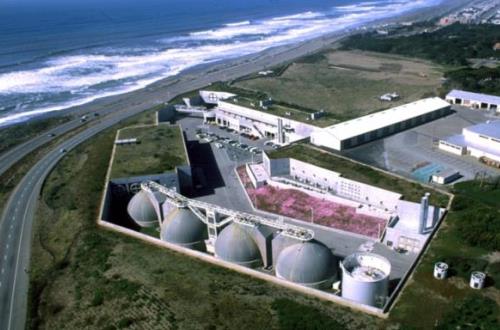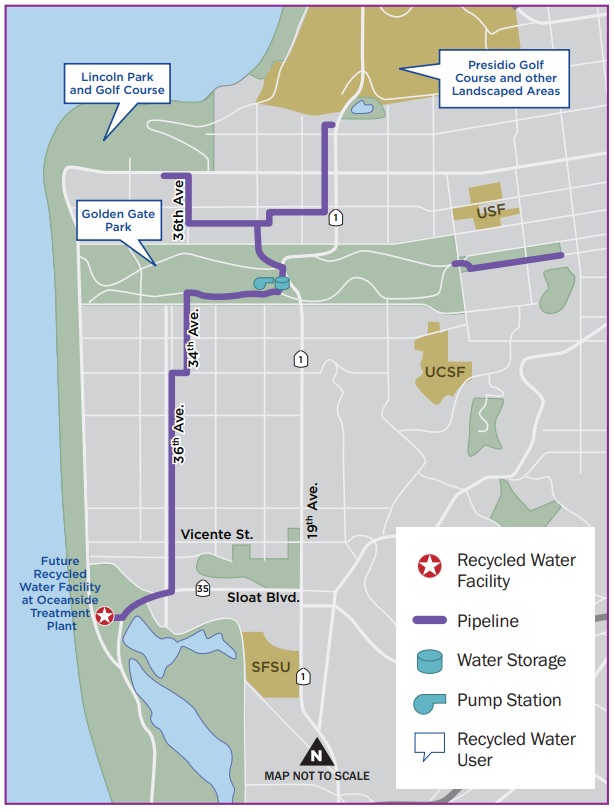
Photo courtesy of SFPUC
Late this summer, the water features in San Francisco’s Golden Gate Park, as well as the irrigation systems at the nearby Lincoln Park golf course, will begin using recycled water from the Westside Enhanced Water Recycling Project located at the Oceanside Water Pollution Control Plant on The Great Highway.
The new $214 million plant will use up to 4.0 mgd of secondary effluent and treat it to Title 22 standards using microfiltration, reverse osmosis and UV advanced oxidation (UVAOP). The recycled water will travel through a new eight-mile underground pipeline to an existing pump station and storage reservoir in the park. A new pump station will deliver the water to the golf course.
Darrell Andrews, Chief Stationary Engineer, will be responsible for operating the new recycling facility, a task he’s looking forward to based on his nearly 20 years of experience with all the city’s wastewater plants, including the closed-loop black water reuse system at the city’s PUC downtown high-rise office tower.
“It’s an honor to spearhead a project like this,” he says. “It’s a step in the right direction for our innovative city, and is part of what we can do to help preserve and recover our water resources.”
The Oceanside plant has an average dry weather flow of approximately 14 mgd, and can handle a wet weather load of 65 mgd (43 mgd treated to secondary level). Following treatment, effluent is discharged to the Pacific Ocean.
A portion of the plant’s effluent will be directed to the new recycling facility. Microfiltration will be used to remove remaining suspended solids, and the RO unit will remove minerals. The UVAOP will disinfect the water as well as oxidize and degrade remaining contaminants.
Andrews says operational tests of the pumps were occurring as this article was being prepared. He expects the recycling plant to be ready for operation by late summer or early fall. Existing Oceanside plant staff are being trained to operate the new equipment, which is being funded partly by the city’s wastewater department, and partly by the water department.
When the system becomes operational, the recycled water will be pumped to Golden Gate Park via the new pipeline, which was placed beneath existing streets.
Once at the park, it will be stored in three existing reservoirs which have a combined capacity of 2.3 million gallons.
A portion of the water will be pumped from the reservoir to the golf course, while the remainder will irrigate the park and fill the lakes and other water features at the park.

Project Facilities and Distribution System (SFPUC)
The Westside Enhanced Water Recycling Project is just the latest in a series of programs San Francisco has undertaken to recover and preserve its water resources.
The city partnered with Daly City to construct infrastructure enabling recycled water from the North San Mateo Sanitation District to be used for irrigation at the Harding Park and Fleming Golf Courses. That project has been in operation since 2012.
Another partnership with the North Coast County Water District, begun in 2014, delivers recycled water to the Sharp Park Golf Course in Pacifica, one of the city’s retail water customers.
The city has also adopted a recycled water ordinance intended to maximize the use of recycled water. The ordinance requires all buildings and facilities in designated areas to use recycled water wherever authorized by the state of California.
While the Westside Enhanced Water Recycling Project features the latest in water purification technology, it is not the first application of wastewater recycling at Golden Gate Park.
The creation of the beautifully landscaped mid-city area was partly accomplished by irrigation with groundwater and raw sewage, according to a document prepared by Nicholas Pinhey of the CWEA History Committee.
“At the start of the 20th century, famed horticulturist and Park Superintendent John McLaren used raw sewage, diverted from sewers in Fulton Street and Lincoln Way, to irrigate the western portion of the park via open ditches,” the document reports.
Odor complaints prompted the construction of a septic tank to remove solids, and septic tank effluent was mixed with groundwater and used to fill ornamental lakes and irrigate about 250 acres, a practice that continued until a lawsuit forced discontinuation in 1931.
The city was committed to recycling, however, and hired an engineer to design a new treatment facility which took in wastewater from nearby neighborhoods, treated it with the activated sludge process–one of the first in the nation. Called the McQueen plant after the McQueen Sewage Disposal Company which built it, the facility operated until the late 1970s, producing between 0.7 and 2.0 million gallons that irrigated as much as 800 acres of the park.
However, new state regulations on recycled water forced it to close and since then Golden Gate Park has been irrigated with groundwater and water from the city’s potable water system.
So, the new plant follows long tradition of using recycled water at Golden Gate Park. And it excites Andrews, who grew up in San Francisco and takes his family to the park to enjoy the outdoors and the pleasant surroundings. He says the recycling project is not only the right thing to do in view of water resources, it’s “personal.”